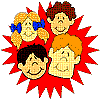Neuroscience For Kids
Laughter and the Brain

 Laughter...it's
fun...it's funny...but why do we do it? Why can't you tickle yourself?
What part of the brain is responsible for laughter and humor? There are
not many answers to these questions because there have not been very many
experiments on the topic of laughter. Part of the reason for this is that
laughter is not a big clinical problem. People do not go to the doctor
because they are laughing and feel good. On the other hand, there are a
some people with brain damage that MAY cause uncontrollable, abnormal
laughter. Also, there is a type of epilepsy with gelastic
seizures...these seizures cause people to laugh.
Laughter...it's
fun...it's funny...but why do we do it? Why can't you tickle yourself?
What part of the brain is responsible for laughter and humor? There are
not many answers to these questions because there have not been very many
experiments on the topic of laughter. Part of the reason for this is that
laughter is not a big clinical problem. People do not go to the doctor
because they are laughing and feel good. On the other hand, there are a
some people with brain damage that MAY cause uncontrollable, abnormal
laughter. Also, there is a type of epilepsy with gelastic
seizures...these seizures cause people to laugh.
 A paper published in the
journal Nature (vol. 391, page 650, 1998) called "Electric Current
Stimulates Laughter" has provided a bit more information about how the
brain is involved with laughter.
A paper published in the
journal Nature (vol. 391, page 650, 1998) called "Electric Current
Stimulates Laughter" has provided a bit more information about how the
brain is involved with laughter. The paper discussed the case of a 16 yr. old girl named "A.K."
who was having surgery to control seizures due to epilepsy. During
surgery, the doctors electrically stimulated A.K.'s cerebral cortex to map
her brain. Mapping of the brain is done to determine the function of
different brain areas and to make sure that brain tissue that will be
removed does not have an important function.
The paper discussed the case of a 16 yr. old girl named "A.K."
who was having surgery to control seizures due to epilepsy. During
surgery, the doctors electrically stimulated A.K.'s cerebral cortex to map
her brain. Mapping of the brain is done to determine the function of
different brain areas and to make sure that brain tissue that will be
removed does not have an important function.
 The
doctors found that A.K. always laughed when they stimulated a small 2 cm
by 2 cm area on her left superior frontal gyrus (part of the frontal lobe of the brain). This brain area is part
of the supplementary motor area. Unlike laughter that happens after brain
damage, the laughter that was produced by electrical stimulation in A.K.
also had a sense of "merriment or mirth". Also, A.K. did NOT have
the type of epilepsy with gelastic seizures. Each time her brain was
stimulated, A.K. laughed and said that something was funny. The thing
that she said caused her to laugh was different each time. A.K. laughed
first, then made up a story that was funny to her. Most people first know
what is funny, then they laugh.
The
doctors found that A.K. always laughed when they stimulated a small 2 cm
by 2 cm area on her left superior frontal gyrus (part of the frontal lobe of the brain). This brain area is part
of the supplementary motor area. Unlike laughter that happens after brain
damage, the laughter that was produced by electrical stimulation in A.K.
also had a sense of "merriment or mirth". Also, A.K. did NOT have
the type of epilepsy with gelastic seizures. Each time her brain was
stimulated, A.K. laughed and said that something was funny. The thing
that she said caused her to laugh was different each time. A.K. laughed
first, then made up a story that was funny to her. Most people first know
what is funny, then they laugh.
 The authors of the paper believe that the area of the brain that caused
laughter in A.K. is part of a larger circuit involving several different
brain areas. Different parts of the circuit may be important for:
The authors of the paper believe that the area of the brain that caused
laughter in A.K. is part of a larger circuit involving several different
brain areas. Different parts of the circuit may be important for:
- the emotions produced by a funny situation (emotional part of humor)
- the "getting it" part of a joke (cognitive, thinking part of humor)
- moving the muscles of the face to smile (motor part of humor).
Other areas of the brain, such as the temporal lobe and hypothalamus, may also participate in laughter and humor.
 So, now we know a
little more about what part of the brain is responsible for humor. This
does not explain why we laugh or why we don't laugh when we tickle
ourselves. Believe it or not, there has been some research into this
area. In fact, researchers at the University of California in San Diego
have even constructed a "Tickle Machine". For these scientists, tickling
is no laughing matter!
So, now we know a
little more about what part of the brain is responsible for humor. This
does not explain why we laugh or why we don't laugh when we tickle
ourselves. Believe it or not, there has been some research into this
area. In fact, researchers at the University of California in San Diego
have even constructed a "Tickle Machine". For these scientists, tickling
is no laughing matter!
 Some scientists believe that laughing caused by tickling is a built-in
reflex because even babies do it. If this is true, then you should be
able to tickle yourself...but you can't, can you? Even if you try to
tickle yourself in exactly the same way that another person tickles you,
you don't laugh. Why is this? The information sent to your spinal cord
and brain should be exactly the same. Apparently for tickling to work,
the brain needs tension and surprise. When you tickle yourself, you know
exactly what will happen...there is no tension or surprise. How the brain
uses this information about tension and surprise is still a mystery, but
there is some evidence that the cerebellum may be involved.
Some scientists believe that laughing caused by tickling is a built-in
reflex because even babies do it. If this is true, then you should be
able to tickle yourself...but you can't, can you? Even if you try to
tickle yourself in exactly the same way that another person tickles you,
you don't laugh. Why is this? The information sent to your spinal cord
and brain should be exactly the same. Apparently for tickling to work,
the brain needs tension and surprise. When you tickle yourself, you know
exactly what will happen...there is no tension or surprise. How the brain
uses this information about tension and surprise is still a mystery, but
there is some evidence that the cerebellum may be involved.

 Everyone smiles and laughs. Even monkeys and apes have some facial
expressions that are similar to human smiles. It is possible that
smiling, laughing and tickling are used to create bonds between babies and
parents. When a parent tickles a baby and the baby responds with a smile
or laugh, the parent laughs and smiles too. In this way, the baby and
parent get to know one another and the baby learns all about laughter by
watching and responding to a parent. What a
happy way to learn!
Everyone smiles and laughs. Even monkeys and apes have some facial
expressions that are similar to human smiles. It is possible that
smiling, laughing and tickling are used to create bonds between babies and
parents. When a parent tickles a baby and the baby responds with a smile
or laugh, the parent laughs and smiles too. In this way, the baby and
parent get to know one another and the baby learns all about laughter by
watching and responding to a parent. What a
happy way to learn!
Is Laughter the Best Medicine?
 The physiological study of laughter has its own name: "gelotology."
Research has shown that laughing is more than just a person's voice and
movement. Laughter requires the coordination of many muscles throughout
the body. Laughter also:
The physiological study of laughter has its own name: "gelotology."
Research has shown that laughing is more than just a person's voice and
movement. Laughter requires the coordination of many muscles throughout
the body. Laughter also:
- increases blood pressure
- increases heart rate
- changes breathing
- reduces levels of certain neurochemicals (catecholamines, hormones).
- provides a boost to the immune system.
 Can laughter improve
health?
It may be a good way for people to relax because muscle tension is reduced
after laughing. There are some cases when a good deep laugh may help
people with respiratory problems by clearing mucus and aiding
ventiliation. Perhaps laughing can also help cardiac patients by giving
the heart a bit of a workout. Some hospitals even have their own "Humor
Rooms," "Comedy Carts," and clown kids in attempts to speed a patient's
recovery and boost morale.
Can laughter improve
health?
It may be a good way for people to relax because muscle tension is reduced
after laughing. There are some cases when a good deep laugh may help
people with respiratory problems by clearing mucus and aiding
ventiliation. Perhaps laughing can also help cardiac patients by giving
the heart a bit of a workout. Some hospitals even have their own "Humor
Rooms," "Comedy Carts," and clown kids in attempts to speed a patient's
recovery and boost morale.
 However, laughter is NOT ALWAYS good medicine. There are a few cases when
laughing actually CAUSED a heart attack or a stroke. Also, immediately
after abdominal surgery, people should not laugh too hard because they
could tear out their stitches accidentally. Care should also be used in
patients with broken ribs. So, try not to be too funny around these
people.
However, laughter is NOT ALWAYS good medicine. There are a few cases when
laughing actually CAUSED a heart attack or a stroke. Also, immediately
after abdominal surgery, people should not laugh too hard because they
could tear out their stitches accidentally. Care should also be used in
patients with broken ribs. So, try not to be too funny around these
people.
 How laughter affects the
nervous system and rest of the body is not completely understood. A new
area of neuroscience called Psychoneuroimmunology" studies the
interactions between the brain and the immune system. The field of
psychoneuroimmunology combines the methods and techniques of psychology,
neuroscience and immunology. Psychoneuroimmunological experiments usually
focus on how stress affects the nervous system and disease states.
Laughter has been shown to cause changes in the autonomic nervous system
and also to alter stress hormone and neurotransmitter levels. For
example, 60 min. of watching a video with the comedian "Gallagher" caused
reductions in the levels of:
How laughter affects the
nervous system and rest of the body is not completely understood. A new
area of neuroscience called Psychoneuroimmunology" studies the
interactions between the brain and the immune system. The field of
psychoneuroimmunology combines the methods and techniques of psychology,
neuroscience and immunology. Psychoneuroimmunological experiments usually
focus on how stress affects the nervous system and disease states.
Laughter has been shown to cause changes in the autonomic nervous system
and also to alter stress hormone and neurotransmitter levels. For
example, 60 min. of watching a video with the comedian "Gallagher" caused
reductions in the levels of:
- cortisol
- growth hormone
- catecholamines
Further research into how a positive attitude affects a person's health need to be done. This will give a whole new meaning to the phrase:
"Fun Science"
See if I can make you laugh with these brain jokes.
For more about laughter and the brain, see:

- The Science of Laughter - Neuroscience for Kids
- The Laughing Brain 1: How We Laugh
- The Laughing Brain 2: A Good Laugh
- "A Ticklish Question" and "Laughing Matters" - Videos from Scientific Amercian Frontiers
- How Laughter Works - from How Stuff Works
- "Laughter" in the January-February 1996 issue of American Scientist
- Laughing Matters
References and further information:
- Berk, L.S., Tan, S.A., Fry, W.F., Napier, B.J., Lee, J.W., Hubbard, R.W., Lewis, J.E. and Eby, W.C. Neuroendocrine and stress hormone changes during mirthful laughter. Am. J. Med. Sci., 298:390-396, 1989.
- Boiten, F. Autonomic response patterns during voluntary facial action. Psychophysiol., 33:123-131, 1996.
- Ekman, P., Levenson, R.W. and Friesen, W.V. Autonomic nervous system activity distinguishes among emotions, Science, 221:1208-1210, 1983.
- Fried, I., Wilson, C.L., MacDonald, K.A. and Behnke, E.J. Electric current stimulates laughter. Nature, 391:650, 1998.
- Fry Jr., W.F. The physiologic effects of humor, mirth, and laughter. JAMA, 267:1857-1858, 1992.
- Provine, R.R., Laughter. A Scientific Investigation, New York: Viking, 2000.
- Yoon, C.K. Don't make me laugh: scientists tackle tickling. J. NIH Research, 9:34-35, 1997.
Copyright © 1996-2015, Eric H. Chudler All Rights Reserved.
